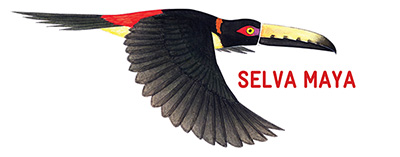
GOVERNANCE
Strategic Coordination Group (GEC) of the Selva Maya
In July 2015, the Selva Maya Strategic Coordination Group was formed and is made up of the regional director of the National Commission of Natural Protected Areas (Mexico), the regional director of the National Council of Protected Areas (Guatemala) and the deputy director of the Forestry Department (Belize). The group’s vision is to become consolidated by 2020 as a recognized entity that coordinates and supports, technically and politically, the implementation of the conservation and sustainable use strategy of the Selva Maya. The goal of the SCG is to develop, coordinate and implement a trilateral comprehensive strategy (Belize-Guatemala-Mexico) for the conservation of the natural and cultural heritage of the Selva Maya. The group meets at least twice a year.
Cross-border Cooperation
Several initiatives exist between Belize, Guatemala and Mexico to strengthen international governance for the protection and preservation of biodiversity and the environment. One is the tri-national Calakmul – Mirador-Río Azul National Park – Rio Bravo initiative. Its goal is to establish a space for dialogue that favors joint cooperation for the conservation of the Selva Maya and this region specifically.
Cross-border cooperation in environmental management and biodiversity conservation in the Selva Maya requires a strategy with a regional approach to encourage the implementation of coordinated action at the various levels of government. This promotes effective biodiversity conservation and natural resource management, and makes it more feasible to curb the enormous threats faced (traffic of flora and fauna, natural resource extraction, forest fires, poaching, land use change, deforestation, forest degradation and more recently, climate) change.
Fortunately, much of this transboundary ecosystem, which is part of the Mesoamerican Biological Corridor, is under some form of protection. Some of these protected areas of global importance include the Calakmul, Balam Kú and Balam Kín reserves in Mexico; the Maya Biosphere Reserve in Guatemala; and the Rio Bravo and Galon Jug reserves in Belize. It is crucial at the operational level for the technical- and field staff in these cross-border natural areas to be able to generate action plans that result in improved coordination activities such as border patrols, information exchange and biological monitoring. Additionally, a challenge like this requires the integration of a regional strategy that enables the participation and representation of the different social groups in the region.
Park Ranger Exchanges
Since 2012 an annual exchange of park rangers from cross-border natural areas in Belize, Guatemala and Mexico occurs. These exchanges have proved to be an excellent place to promote discussion about threats in the region and they have also resulted in the creation of joint agendas for strategy development and action plans to address threats and thus raise environmental governance in the region.
Strategies agreed to so far include border patrols, information exchange, capacity building (e.g., management and fire suppression, use of various equipment), and the development of biological monitoring protocols for key species, among others. So far, rangers of the three countries have received training in multiple areas, such as combating forest fires, the use of navigation equipment, using camera traps, data management, etc. All of this has helped increase the institutional presence at a local level. However, to ensure the impacts of these efforts in the medium and long term, it is necessary to establish a cooperation framework at a political level in the three countries that facilitates and sponsors these meetings both technically and financially.

